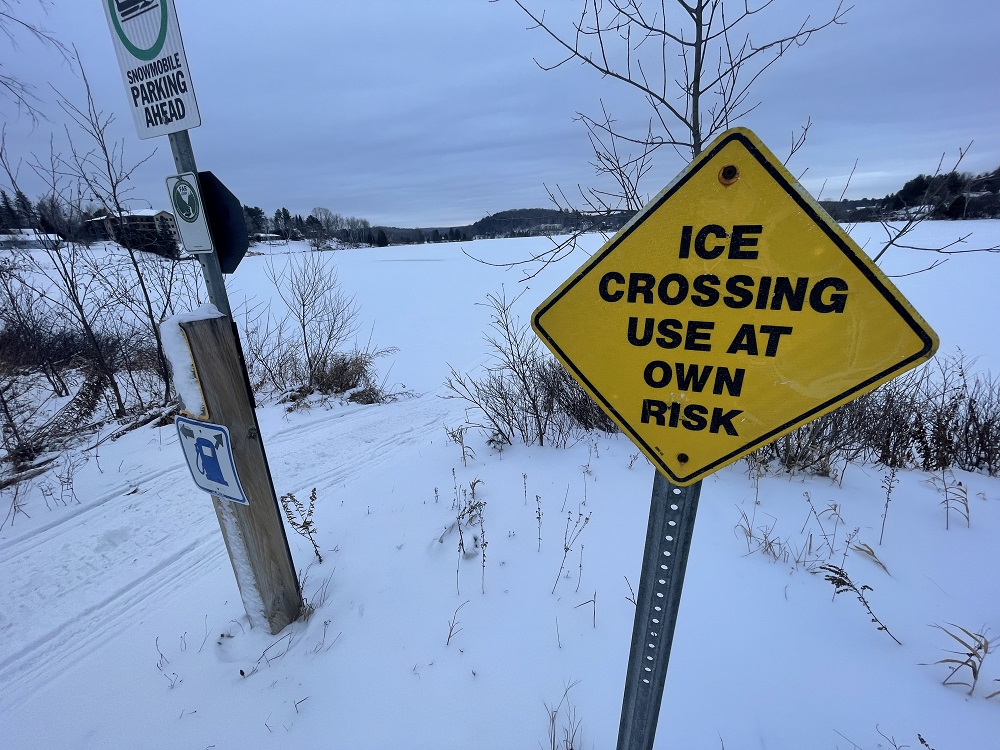January is often when winter activities kick into high gear. In Haliburton County, that means using the vast lakes as hockey rinks, snowmobile tracks and ice fishing locales.
Minden Hills fire chief, Nelson Johnson, said he personally doesn’t recommend anyone venture out on the ice. Each year, his department responds to one to two icerelated emergencies. That’s not a lot, he said, but the ideal number is zero.
“There’s a lot of factors to why ice is good,” he said. “You can’t just go by thickness and you can’t just go by temperature.”
He said air temperature, along with the flow of water under the ice, recent snow, and temperature changes all play a factor on how ice develops.
Thick ice, said Johnson, doesn’t necessarily mean safe conditions.
“We have lakes, rivers and streams with ice that has flowing water underneath,” said Johnson.
It’s estimated ice with moving water under it is 15-20 per cent less strong than normal lake ice. The amount of snow can also change the danger level. Snow insulates ice and can cause it to deteriorate.
A deep lake, such as Kennisis, as opposed to Kashagawigamog, will take a lot longer to freeze to a safe level, Johnson said.
“That’s kind of a problem we have here,” said Johnson. “We have all different sizes, shapes and depths and amounts of water in these lakes.”
He said the only safe way to access ice is to test to know what the ice is doing.
Blue ice is usually thicker, and if it’s eight10 inches thick, it’s safe for fishing and taking a vehicle across.
However, Johnson said understanding how ice forms is key. Ice can form at about four degrees celsius. Ice particles drop into the water, sink and then become buoyant as they freeze into ice crystals and rise back up to the surface to form an ice surface. Abrupt temperature changes can interrupt this process.
“When it starts to warm, it always warms up close to the shores. That’s where a lot of people do their skating, close to the shores.”
On still bodies of water, Johnson said he recommends four inches or thicker. “Four inches is for one person sitting,” he said. “Six inches for a group.”
Johnson recommends those who head out on the ice bring a cell phone in a waterproof bag, as well, to “always let someone know you’re going out there.”
HCSA recommends
The Haliburton County Snowmobile Association maintains 74 kilometres of lake routes. The ice on each lake is continually monitored and routes are staked at 100 metre intervals at optimal crossing locations. Members drill test holes to ensure ice quality and thickness.
“The criteria is different for each lake,” said association president John Enright. The association has rarely opened water crossings this early in the year.
Once trails open later in winter, he said riders should stay within the set routes, with the compressed snow from snowmobile tracks packing down frost.
“You really have to know your ice and where you’re going,” Enright said. “I would never randomly go out on any lake in this County exploring.”
OPP driving tips
With the onset of winter weather, members of the Haliburton Highlands Detachment of the Ontario Provincial Police (OPP) are urging drivers to drive safely this winter.
• Before starting out, prepare yourself for safe winter driving by planning your trip. Check road conditions by visiting Ontario 511. Carry a fully charged cell phone to contact emergency services if you experience trouble.
• In bad weather, reconsider unnecessary travel and stay home. If you do need to drive, adjust accordingly. Slow down and leave ample space between you and the vehicle in front of you. If you experience trouble, park your vehicle well off the roadway, if safe to do so, and stay in your vehicle until help arrives.
• Make sure your heater, defroster and all lights are working. Clear your vehicle of snow and ice, fill up the windshield washer fluid, and keep your fuel tank at least half full.
• Drivers are also reminded to stay back from working snowplows with flashing blue lights and give them space to safely do their jobs. These vehicles travel slower than regular traffic and will be active on roadways before, during and after a snowfall or storm. Do not pass them as visibility can be significantly reduced by blowing snow created from the operation of these vehicles. Learn more about safe winter driving: ontario.ca/page/winterdriving





